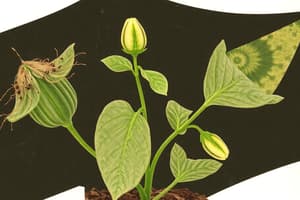Podcast
Questions and Answers
What are the 3 basic organs evolved in plants?
What are the 3 basic organs evolved in plants?
- Pistils, stamens, and sepals
- Roots, stems, and leaves (correct)
- Flowers, fruits, and seeds
- Branches, twigs, and buds
What is the function of the root system in plants?
What is the function of the root system in plants?
- Anchor, store food, absorb, and conduct water and minerals (correct)
- Reproduction and seed dispersal
- Photosynthesis and energy production
- Protection against herbivores and pathogens
Where does the absorption of water and minerals mainly occur in most plants?
Where does the absorption of water and minerals mainly occur in most plants?
- Throughout the entire root system evenly
- Near the root tips with tiny root hairs (correct)
- In the stem's vascular tissues
- On the surface of leaves
What is the primary function of meristem in plants?
What is the primary function of meristem in plants?
What reflects the evolutionary history of plants as terrestrial and aquatic organisms?
What reflects the evolutionary history of plants as terrestrial and aquatic organisms?
Flashcards are hidden until you start studying
Study Notes
Basic Organs of Plants
- Three basic organs of plants are roots, stems, and leaves.
- Roots anchor the plant, absorb water and nutrients, and store food.
- Stems support leaves and flowers, transport fluids between roots and leaves, and store nutrients.
- Leaves are primarily involved in photosynthesis and gas exchange.
Root System Functions
- The root system stabilizes the plant by securing it in the soil.
- Roots absorb water and essential minerals from the soil to support growth.
- They store energy and nutrients, helping the plant survive adverse conditions.
Water and Mineral Absorption
- In most plants, water and minerals are primarily absorbed through the root hairs.
- Root hairs increase surface area, enhancing absorption efficiency.
Meristem Function
- Meristem tissue is responsible for plant growth, allowing for continuous cell division.
- It is located at the tips of roots and stems, enabling elongation and new tissue formation.
Evolutionary History Reflection
- Plant evolution reflects adaptation to terrestrial and aquatic environments through structural and functional changes.
- Traits like cuticles and stomata evolved for water retention and gas exchange in land plants.
Studying That Suits You
Use AI to generate personalized quizzes and flashcards to suit your learning preferences.




